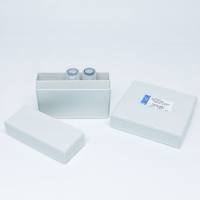Phenotypic Analysis of BAT versus WAT Differentiation
互联网
- Abstract
- Table of Contents
- Materials
- Figures
- Literature Cited
Abstract
The Western world is in the midst of an epidemic of obesity, which is the cause of severe clinical complications such as type 2 diabetes, hypertension, and cardiovascular disease. Obesity develops when energy intake chronically exceeds energy expenditure; thus, either reducing the energy intake and/or increasing the energy expenditure has been used in the treatment and prevention of obesity. On a cellular level, energy storage is mediated by white adipocyte tissue (WAT). In contrast, brown adipose tissue (BAT) contributes to body temperature and metabolic homeostasis by metabolizing lipids and glucose. Adipose tissue is a notoriously difficult tissue to work with, due to the high content of triglycerides and the fragility of the cells. In this unit, several approaches to analysis of BAT and WAT are described that overcome these limitations. Curr. Protoc. Mouse Biol . 3:205?216 © 2013 by John Wiley & Sons, Inc.
Keywords: white adipose tissue; brown adipose tissue; adipogenesis; adipocytes; FACS; cryosectioning
Table of Contents
- Introduction
- Basic Protocol 1: Fluorescent‐Activated Cell Sorting (FACS) of Mature Adipocytes
- Basic Protocol 2: qPCR Analysis of Brown Versus White Adipose Tissue
- Basic Protocol 3: Cryosectioning and Staining of Brown and White Adipose Tissue
- Reagents and Solutions
- Commentary
- Literature Cited
- Figures
- Tables
Materials
Basic Protocol 1: Fluorescent‐Activated Cell Sorting (FACS) of Mature Adipocytes
Materials
Basic Protocol 2: qPCR Analysis of Brown Versus White Adipose Tissue
Materials
Table 3.1.1 MaterialsPrimer Sequences for qRT‐PCR Reactions
Basic Protocol 3: Cryosectioning and Staining of Brown and White Adipose Tissue
Materials
|
Figures
-
Figure 1. Representative FACS plots from mature adipocyte fraction of interscapular adipose tissue after cold acclimatization. (A ) The dot plot represents a recording of the cells on the sample and the gating on the upper cell population of mature adipocytes. (B ) The histogram shows two different peaks, with the right one representing the GFP signal of part of the gated population. (C ) The GFP‐positive brown adipocyte population is re‐gated so that pure mature brown adipocytes are sorted. (D ) Dot plot of 7‐AAD staining and separation of alive (left) and dead (right) population. View Image -
Figure 2. Pparγ and Ucp1 expression levels in different adipose tissue cell fractions in vivo. Relative mRNA levels in separated adipocyte (adipo) and stromal‐vascular fractions (SVF) from different adipose tissues of C57BL/6 mice housed at 23°C are represented as bars. View Image -
Figure 3. Confocal images of immunohistochemical staining of murine BAT for UCP1 protein. Left panels show the DAPI nuclear counterstaining; right panels show the Alexa647 signal of the conjugated secondary antibody. Top: IgG isotype control as primary antibody; bottom: rabbit anti UCP1 primary antibody. View Image -
Figure 4. Confocal images of murine BAT from Ucp1‐GFP animals or transgene‐negative littermates. Left panels show the DAPI nuclear counterstaining; right panels show the endogenous GFP fluorescence or background fluorescence. Top: transgene‐negative tissue; bottom: transgene‐positive tissue. View Image
Videos
Literature Cited
| Literature Cited | |
| Cinti, S. 2005. The adipose organ. Prostaglandins Leukot. Essent. Fatty Acids 73:9‐15. | |
| Jaradat, S.A., Ko, M.S., and Grossman, L.I. 1998. Tissue‐specific expression and mapping of the Cox7ah gene in mouse. Genomics 49:363‐370. | |
| MacDougald, O.A., Hwang, C.S., Fan, H., and Lane, M.D. 1995. Regulated expression of the obese gene product (leptin) in white adipose tissue and 3T3‐L1 adipocytes. Proc. Natl. Acad. Sci. U.S.A. 92:9034‐9037. | |
| Nedergaard, J., Bengtsson, T., and Cannon, B. 2011. New powers of brown fat: Fighting the metabolic syndrome. Cell Metab. 13:238‐240. | |
| Petrovic, N., Walden, T.B., Shabalina, I.G., Timmons, J.A., Cannon, B., and Nedergaard, J. 2010. Chronic peroxisome proliferator‐activated receptor gamma (PPARgamma) activation of epididymally derived white adipocyte cultures reveals a population of thermogenically competent, UCP1‐containing adipocytes molecularly distinct from classic brown adipocytes. J. Biol. Chem. 285:7153‐7164. | |
| Rajwa, B. 2005. Modern confocal microscopy. Curr. Protoc. Cytom. 31:12.3.1‐12.3.12. | |
| Rosenwald, M., Perdikari, A., Rulicke, T., and Wolfrum, C. 2013. Bi‐directional interconversion of brite and white adipocytes. Nat. Cell. Biol. 15:659‐667. | |
| Steppan, C.M., Bailey, S.T., Bhat, S., Brown, E.J., Banerjee, R.R., Wright, C.M., Patel, H.R., Ahima, R.S., and Lazar, M.A. 2001. The hormone resistin links obesity to diabetes. Nature 409:307‐312. | |
| Tseng, Y.H., Cypess, A.M., and Kahn, C.R. 2010. Cellular bioenergetics as a target for obesity therapy. Nat. Rev. Drug Discov. 9:465‐482. | |
| Walden, T.B., Hansen, I.R., Timmons, J.A., Cannon, B., and Nedergaard, J., 2012. Recruited vs. nonrecruited molecular signatures of brown, “brite,” and white adipose tissues. Am. J. Physiol. Endocrinol. Metab. 302:E19‐E31. | |
| Wu, J., Bostrom, P., Sparks, L.M., Ye, L., Choi, J.H., Giang, A.H., Khandekar, M., Virtanen, K.A., Nuutila, P., Schaart, G., Huang, K., Tu, H., van Marken Lichtenbelt, W.D., Hoeks, J., Enerback, S., Schrauwen, P., and Spiegelman, B.M. 2012. Beige adipocytes are a distinct type of thermogenic fat cell in mouse and human. Cell 150:366‐376. | |
| Young, P., Arch, J.R., and Ashwell, M. 1984. Brown adipose tissue in the parametrial fat pad of the mouse. FEBS Lett. 167:10‐14. | |
| Zhou, Z., Yon Toh, S., Chen, Z., Guo, K., Ng, C.P., Ponniah, S., Lin, S.C., Hong, W., and Li, P. 2003. Cidea‐deficient mice have lean phenotype and are resistant to obesity. Nat. Genet. 35:49‐56. |








